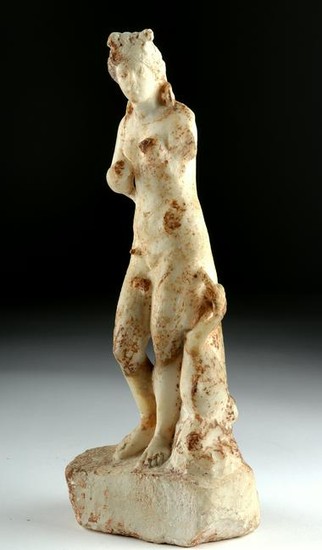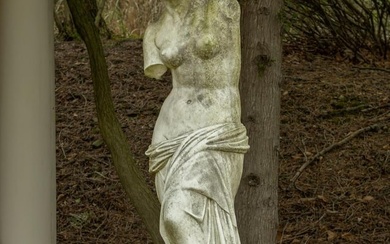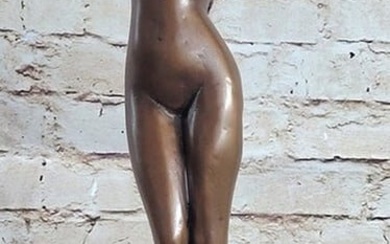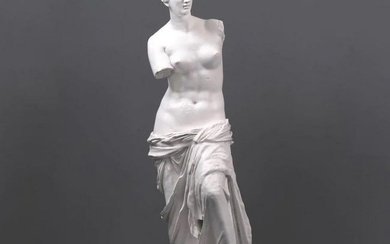Greek Marble Statue of Aphrodite w/ Dolphin
Magna Graecia, ca. 300 BCE, found in Sicily. Finely carved in the round, a marble statue of Aphrodite (Roman Venus), the goddess of love born from the sea, with a dolphin by her side symbolizing her birth from the sea but also serving as a support. Aphrodite stands in contrapposto with her right leg slightly bent and her weight shifted to her left leg. Although nude, her pose connotes modesty. With her head turned to the left, the goddess averts her gaze away from the viewer. Her oval face presents delicate features including almond-shaped eyes, an aquiline nose, heart-shaped lips, and softly contoured cheeks - all framed by a wavy coiffure with an upraised, almost bow-shaped front section (very similar to the style of the Venus Mazarin's coiffure), a low chignon at the nape of her neck, and flowing tresses over her shoulders - truly an ideal of feminine beauty. Size: 12.625" H (32.1 cm)
Although her right hand is missing, it most likely once crossed her breast as the right thumb still graces her breast. In addition, while her left arm is missing, it may have crossed her genitalia - note evidence of a point of contact between the arm and her hip and possibly a thumb slightly left of her genitalia.
Aphrodite accompanied by dolphins is a theme that was quite popular in the Classical world. A beloved Greek statue by Praxiteles (ca. 350 BCE) inspired many Hellenistic variants starting around 100 BCE as well as the Roman Mazarin Venus (ca. 2nd century CE) and Renaissance pieces that were part of the revival of the Classical tradition. The Renaissance fascination with Venus was also evident in Raphael and Durer's imagery - Raphael's "Venus and Cupid Carried by Dolphins" and Durer's "Venus on a Dolphin".
Provenance: private California, USA collection
All items legal to buy/sell under U.S. Statute covering cultural patrimony Code 2600, CHAPTER 14, and are guaranteed to be as described or your money back.
A Certificate of Authenticity will accompany all winning bids.
We ship worldwide to most countries and handle all shipping in-house for your convenience.
#135211
Condition Report: Losses to arms, high pointed areas of coiffure and visage, and edges of plinth. Repairs and restoration to lower legs and plinth. Head reattached with possible restoration over break lines. Normal surface wear commensurate with age with areas of earthen encrustation and white mineral deposits.
View it on
Estimate
Time, Location
Auction House
Magna Graecia, ca. 300 BCE, found in Sicily. Finely carved in the round, a marble statue of Aphrodite (Roman Venus), the goddess of love born from the sea, with a dolphin by her side symbolizing her birth from the sea but also serving as a support. Aphrodite stands in contrapposto with her right leg slightly bent and her weight shifted to her left leg. Although nude, her pose connotes modesty. With her head turned to the left, the goddess averts her gaze away from the viewer. Her oval face presents delicate features including almond-shaped eyes, an aquiline nose, heart-shaped lips, and softly contoured cheeks - all framed by a wavy coiffure with an upraised, almost bow-shaped front section (very similar to the style of the Venus Mazarin's coiffure), a low chignon at the nape of her neck, and flowing tresses over her shoulders - truly an ideal of feminine beauty. Size: 12.625" H (32.1 cm)
Although her right hand is missing, it most likely once crossed her breast as the right thumb still graces her breast. In addition, while her left arm is missing, it may have crossed her genitalia - note evidence of a point of contact between the arm and her hip and possibly a thumb slightly left of her genitalia.
Aphrodite accompanied by dolphins is a theme that was quite popular in the Classical world. A beloved Greek statue by Praxiteles (ca. 350 BCE) inspired many Hellenistic variants starting around 100 BCE as well as the Roman Mazarin Venus (ca. 2nd century CE) and Renaissance pieces that were part of the revival of the Classical tradition. The Renaissance fascination with Venus was also evident in Raphael and Durer's imagery - Raphael's "Venus and Cupid Carried by Dolphins" and Durer's "Venus on a Dolphin".
Provenance: private California, USA collection
All items legal to buy/sell under U.S. Statute covering cultural patrimony Code 2600, CHAPTER 14, and are guaranteed to be as described or your money back.
A Certificate of Authenticity will accompany all winning bids.
We ship worldwide to most countries and handle all shipping in-house for your convenience.
#135211
Condition Report: Losses to arms, high pointed areas of coiffure and visage, and edges of plinth. Repairs and restoration to lower legs and plinth. Head reattached with possible restoration over break lines. Normal surface wear commensurate with age with areas of earthen encrustation and white mineral deposits.







